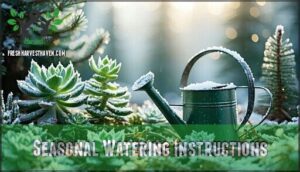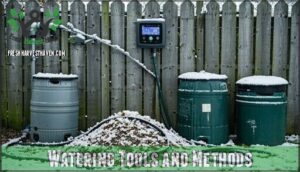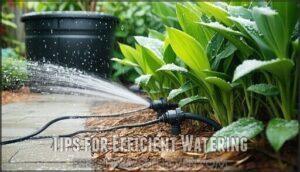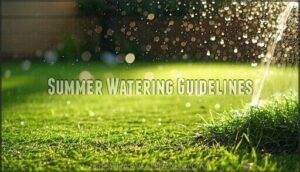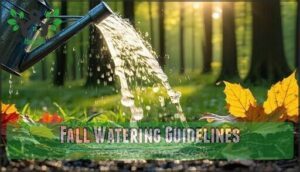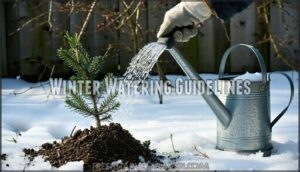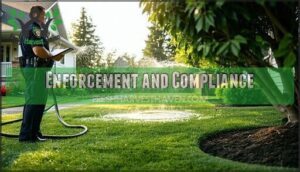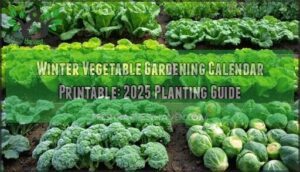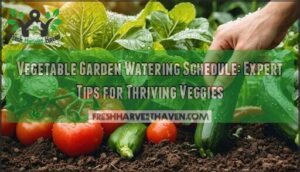This site is supported by our readers. We may earn a commission, at no cost to you, if you purchase through links.
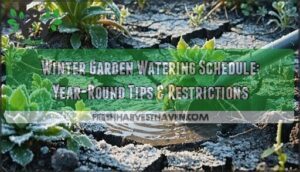 Your winter garden watering schedule depends on your municipality’s water conservation rules, which typically restrict irrigation to early morning hours (4:00-10:00 AM) or evening periods (4:00-8:00 PM).
Your winter garden watering schedule depends on your municipality’s water conservation rules, which typically restrict irrigation to early morning hours (4:00-10:00 AM) or evening periods (4:00-8:00 PM).
Most areas assign specific watering days based on your home’s address—odd numbers water on certain days, even numbers on others.
During winter months, you’ll need less frequent watering since cooler temperatures reduce evaporation and plant water needs.
Check your local water department’s current restrictions, as schedules often change between daylight saving time and standard time periods.
Smart timing and proper techniques can keep your landscape healthy while avoiding costly violation fines and supporting community conservation efforts.
Table Of Contents
- Key Takeaways
- Water Conservation Basics
- Irrigation Schedules
- Watering Guidelines
- Enforcement and Compliance
- Frequently Asked Questions (FAQs)
- How often should you water plants in winter?
- When should you water your garden?
- Should you water your garden in winter?
- How often should you water a winter vegetable garden?
- What time should you water a plant?
- How do you take care of a plant in winter?
- How often do you water a winter garden?
- What is the winter watering schedule?
- What is the best watering schedule for a garden?
- What is the 1/2/3/2:1 lawn watering technique?
- Conclusion
Key Takeaways
- You’ll follow address-based watering restrictions with odd-numbered homes watering Wednesdays/Saturdays and even-numbered homes using Thursdays/Sundays during daylight saving time
- You’ll reduce your watering frequency by 75% in winter since plants need less water during dormancy, checking soil moisture 2-4 inches deep before watering
- You’ll water only during permitted hours (before 10 AM or after 4 PM) to minimize evaporation and avoid $25 fines for repeat violations
- You’ll save 30% on water bills annually by following municipal conservation rules while maintaining healthy plants through proper seasonal schedule adjustments
Water Conservation Basics
Water conservation protects your community’s future while keeping your lawn healthy through smart watering practices. You’ll save money on bills and help preserve this essential resource for generations to come.
Importance of Water Conservation
Throughout your winter garden watering journey, ecosystem preservation stands as your most important responsibility.
Every drop you save today creates a healthier tomorrow for our shared planet.
You’re not just maintaining plants—you’re protecting water resources for future generations while embracing community responsibility.
Smart winter garden watering practices showcase sustainable practices that reduce usage effectively.
When you follow proper watering schedule winter guidelines and implement water conservation tips, you’re contributing to a healthier planet.
Your winter plant watering decisions today create lasting environmental impact, making water conservation an investment in tomorrow’s world.
Principles of Water Conservation
Water conservation principles center around using only what nature can replenish, creating a sustainable cycle for your winter garden watering needs.
Smart watering practices protect local ecosystems while ensuring your landscape thrives year-round.
- Reduce runoff by watering slowly, allowing soil moisture to absorb gradually
- Limit evaporation through early morning or evening watering schedule winter timing
- Efficient irrigation techniques like rainwater harvesting maximize every drop’s impact
Role of Community Involvement
Building stronger communities requires everyone’s participation, and water conservation offers the perfect opportunity to connect with neighbors while protecting our shared resources.
When you join volunteer programs and education initiatives, you’ll discover practical techniques for implementing your winter garden watering schedule effectively.
Community responsibility extends beyond individual actions to collective accountability through reporting violations and supporting sustainable practices.
To improve water retention, consider amending soil with compost.
| Community Action | Impact | Getting Started |
|---|---|---|
| Volunteer Programs | Hands-on conservation skills | Contact local water districts |
| Education Initiatives | Neighborhood awareness | Attend workshops, share knowledge |
| Reporting Violations | Schedule compliance | Call enforcement hotlines |
| Water Conservation Groups | Long-term community initiatives | Join existing programs |
| Neighbor Networks | Shared winter plant watering tips | Start informal discussions |
Transform your neighborhood into a water conservation success story by becoming an active participant in these meaningful community initiatives.
Irrigation Schedules
Understanding Winter Garden’s irrigation schedule helps you stay compliant while maintaining a healthy lawn year-round.
Your watering days depend on your address number and whether it’s Daylight Saving Time or Eastern Standard Time.
Daylight Savings Time Schedule
During Daylight Saving Time, which runs from spring forward through summer watering season, your winter garden watering schedule expands to twice weekly.
Schedule changes require time adjustment when clocks spring forward, giving you a larger weekly allotment for watering schedule plants.
Here’s your Daylight Saving Time winter garden watering schedule:
- Odd addresses: Water Wednesdays and Saturdays only
- Even addresses: Water Thursdays and Sundays only
- Non-residential properties: Water Tuesdays and Fridays only
Eastern Standard Time Schedule
When Eastern Standard Time arrives, your winter garden watering shifts to once-weekly watering under strict weekly restrictions.
This winter schedule determines watering schedule timing based on address types: odd-numbered homes water Saturdays, even-numbered properties use Sundays, while non-residential locations stick to Tuesdays.
Time limitations remain unchanged—water before 10 a.m. or after 4 p.m. to prevent evaporation during Eastern Standard Time, ensuring your watering schedule plants receive ideal moisture absorption throughout winter months.
Odd/Even Numbered Home Restrictions
Your home’s address number determines your Address-Based Watering days, creating a fair system that prevents water shortages.
Odd-numbered homes water Wednesdays and Saturdays during daylight saving time, while even-numbered homes use Thursdays and Sundays.
During winter garden watering periods under Eastern Standard Time, you’ll shift to once-weekly schedules. Mulching advantages help retain soil moisture, reducing the need for frequent watering.
Follow these Schedule Adherence Tips for proper Compliance Monitoring:
- Check your address number to confirm your designated watering days under oddeven address rules
- Set phone reminders for Weekend Watering sessions within approved watering times
- Water only during permitted hours, avoiding the 10 a.m.–4 p.m. Restriction Timeframes
- Install automatic rain sensors to prevent unnecessary irrigation during storms
- Track your watering schedule changes when daylight saving switches occur
Non-Residential Property Restrictions
All commercial properties must follow specific Commercial Watering Days and watering times under the county ordinance.
Business Water Usage is restricted to Tuesdays and Fridays during Daylight Saving Time, but only Tuesdays during Eastern Standard Time.
HOA Restrictions and Industrial Water Needs require compliance with these water restrictions.
No irrigation occurs between 10 a.m. and 4 p.m., with watering duration limited to one hour per zone.
Agricultural Irrigation Rules may have separate requirements.
Watering Guidelines
You’ll want to follow specific watering techniques that change with the seasons to keep your lawn and garden healthy while meeting Winter Garden’s conservation requirements.
These guidelines help you water efficiently during different times of the year, from establishing new landscaping to maintaining mature plants through seasonal cycles, which is crucial for conservation.
Watering Techniques for New Landscaping
When installing new sod or landscaping, you’ll need proper watering techniques to guarantee successful root establishment.
Proper watering techniques during installation create the foundation for thriving, long-lasting landscapes.
Water daily for thirty days, applying three-quarters inch per session for maximum soil hydration**.
Check moisture levels regularly, avoiding overwatering that causes runoff.
Mulch application around new plants reduces evaporation substantially.
After initial establishment, begin gradual reduction to standard Winter Garden watering schedules for compliance.
Seasonal Watering Instructions
Adapting your winter garden watering schedule requires understanding seasonal changes and plant-specific needs.
Your plants’ watering frequency shifts dramatically during winter months, demanding careful soil moisture monitoring and weather adjustments to prevent root damage.
- Monitor soil moisture weekly using your finger or moisture meter
- Adjust watering times to early morning hours for ideal absorption
- Reduce frequency substantially as winter vegetables and flowers need less water
Watering Tools and Methods
Three essential watering tools transform your winter irrigation routine.
Drip irrigation and soaker hoses deliver precise moisture directly to root zones, while smart controllers automatically adjust schedules based on soil moisture winter conditions.
Rain barrels capture natural precipitation for eco-friendly watering, and adjustable hose nozzles provide targeted control.
These watering techniques winter guarantee efficient water distribution while maintaining healthy plants during cooler months.
Proper planning helps with winter drip irrigation.
Tips for Efficient Watering
Smart winter garden watering starts with understanding your landscape’s needs.
Soil moisture monitoring prevents overwatering, while drip irrigation delivers water directly to roots with minimal waste.
Here are four essential efficiency tips:
- Smart sprinklers with weather sensors automatically adjust watering schedules based on rainfall and temperature changes
- Mulch application around plants retains moisture and reduces evaporation by up to 50%
- Rainwater harvesting systems collect free water for your winter watering guide needs
- Check soil moisture winter levels before irrigating to avoid unnecessary watering frequency winter increases
Consider using specialized winter mulch for added protection.
Spring Watering Guidelines
Spring brings renewed growth, making proper hydration timing critical for your landscape’s success.
Follow these guidelines to maximize your spring watering frequency while conserving precious water resources:
- Monitor soil moisture weekly, adjusting when rainfall drops below one inch
- Water twice weekly when temperatures consistently exceed 40°F
- Schedule early morning sessions to minimize evaporation losses
- Balance plant needs with weather impact to prevent overwatering damage
Summer Watering Guidelines
Summer’s intense heat demands strategic summer irrigation to prevent heat stress while maintaining ideal soil moisture. Your watering schedule should prioritize early morning sessions when evaporation rates are lowest, ensuring maximum plant hydration efficiency.
| Watering Type | Best Time | Duration |
|---|---|---|
| Established Lawns | 6-8 AM | 25-30 minutes |
| New Landscaping | Before 10 AM | Daily for 30 days |
| Container Plants | Early morning/evening | 10-15 minutes |
Watering frequency adjustments become critical during heat wave watering conditions. Monitor your lawn’s response patterns, as summer watering guidelines emphasize evaporation reduction through proper timing rather than increased volume, protecting both your plants and water resources.
Fall Watering Guidelines
Fall brings the perfect opportunity to reduce frequency in your watering schedule, as plants prepare for plant dormancy.
Check soil moisture regularly—autumn rains often handle the job for you.
Mulch benefits include protecting roots and retaining moisture during temperature swings.
For ideal plant health, consider how compost improves soil.
Focus your fall watering on deep, less frequent sessions that encourage strong root systems before winter arrives.
Winter Watering Guidelines
Throughout winter’s harsh embrace, your garden’s watering needs shift dramatically, requiring careful attention to dormancy needs and plant sensitivity.
Winter garden watering demands precision since reduced frequency becomes vital for healthy plants.
Monitor these essential winter watering factors:
- Check soil moisture 2-4 inches deep before watering
- Water only when air temperatures exceed 40°F for proper absorption
- Apply frost protection through deep, infrequent watering sessions
- Focus on newly planted trees and shrubs during dormant plant watering periods
Checking moisture levels requires reliable meter technology.
Your winter watering guide emphasizes cold weather watering timing and winter garden care techniques.
Enforcement and Compliance
Understanding Winter Garden’s watering enforcement helps you avoid costly fines while maintaining your landscape properly.
You’ll face a warning for your first violation, then $25 fines for each repeat offense.
But exceptions exist for new landscaping with proper documentation.
Violation Fines and Appeals
Why pay the price for watering violations when you can follow the rules?
First-time violators receive warnings, but repeat offenses trigger $25 fines that accumulate quickly.
The appeal process requires a written request with a $25 filing fee within 30 days of notification.
Unpaid fines get added to your water bill, creating ongoing payment obligations.
Reporting violations helps maintain community compliance—call (407) 254-9850 for assistance or questions about violation enforcement.
| Fine Type | Amount | Payment Options | Appeal Cost | Notes |
|---|---|---|---|---|
| Warning | $0 | N/A | N/A | First violation only |
| Repeat Offense | $25 | Online/Mail | $25 | Added to water bill |
| Appeal Deadline | N/A | N/A | $25 | Within 30 days |
| Unpaid Fines | $25+ | Water Bill | N/A | 30-day deadline |
New Sod/Landscaping Exceptions
New installations enable flexibility in the winter garden watering schedule through the new sod/landscaping exception. You can water newly installed sod daily for thirty days, then every other day for another thirty days, regardless of your address’s standard restrictions.
Sod establishment and plant establishment require consistent moisture during this critical period. Keep proof required documentation handy, as enforcement officers verify legitimate installations to prevent watering violations.
- Daily watering permitted during first month of sod installation
- Extended watering shifts to every-other-day schedule for second month
- Landscape establishment documentation must be readily available for inspection
- Adjustment requests may be submitted for billing concerns during establishment periods
Proof of Installation Requirements
When establishing new sod exceptions for your winter garden watering schedule, you must provide acceptable documentation proving your installation timeline.
Utility verification requires dated receipts, delivery slips, or contractor invoices showing sod installation details.
To help your plants thrive, consider applying mulch correctly to insulate the root systems.
| Documentation Type | Requirements |
|---|---|
| Sales Receipt | Dated proof with address |
| Delivery Slip | Installation date verification |
| Contractor Invoice | Licensed installer details |
| Photo Evidence | Timestamped installation images |
| Work Order | Project completion certificate |
Submit proof of installation within 10-14 days to maintain adjustment eligibility during your compliance period for new landscaping.
Contact Information for Assistance
Need help with Winter Garden watering schedule questions or water restrictions? The city provides multiple contact options for residents seeking assistance with conservation programs and compliance issues.
- Report Violations – Call (407) 254-9850 for watering schedule infractions or suspected waste
- Billing Questions – Contact utilities for sod exception documentation and usage inquiries
- Appeal Process – Submit written requests with $25 fee for violation disputes
Winter garden watering doesn’t have to be confusing with proper support available.
Frequently Asked Questions (FAQs)
How often should you water plants in winter?
Plant watering drops by 75% during winter months since growth slows dramatically.
You’ll need to water most plants every 7-14 days instead of weekly, checking soil moisture first to avoid overwatering damage.
When should you water your garden?
Water your garden early morning (6-10 AM) or late afternoon (4-6 PM) when temperatures are cooler.
This timing reduces evaporation, prevents leaf scorch, and allows plants to absorb moisture effectively before heat stress.
Should you water your garden in winter?
A penny saved is a penny earned," and winter watering saves both water and plants.
You should water your garden sparingly in winter, focusing on newly planted areas and checking soil moisture regularly since dormant plants need less hydration, which aligns with the idea that a penny saved is a penny earned.
How often should you water a winter vegetable garden?
Most winter vegetables need deep watering once or twice weekly, depending on rainfall and soil moisture.
Check soil depth with your finger—if it’s dry two inches down, it’s time to water thoroughly.
What time should you water a plant?
Timing isn’t just about convenience—it’s about giving your green friends their best shot at thriving.
You’ll want to water during the cooler morning hours or evening, avoiding that brutal 10 a.m. to 4 p.m. window when evaporation steals your efforts away, to ensure you’re providing the best conditions for your plants to succeed with thriving.
How do you take care of a plant in winter?
During colder months, you’ll need to adjust your plant care routine substantially.
Reduce watering frequency since plants absorb less moisture, provide adequate light through repositioning or grow lights, and maintain consistent indoor temperatures.
Protecting from drafts is also crucial while adjusting your care routine to ensure the health and well-being of your plants.
How often do you water a winter garden?
Your garden’s thirst diminishes substantially during cooler months, requiring less frequent attention than summer’s demanding schedule.
Water deeply but infrequently, typically once or twice weekly, checking soil moisture first to avoid overwatering your plants, and ensure you water deeply.
What is the winter watering schedule?
During colder months, you’ll water your garden less frequently since plants require minimal moisture and slow growth reduces their needs. Most winter gardens thrive with deep watering once weekly.
What is the best watering schedule for a garden?
You’ll want to water early morning or late evening, avoiding 10 a.m. to 4 p.m. when evaporation peaks.
Follow local restrictions, check soil moisture regularly, and adjust frequency based on seasons and plant needs.
What is the 1/2/3/2:1 lawn watering technique?
The 1/2/3/2:1 watering technique isn’t a recognized lawn care method.
You might be thinking of deep, infrequent watering—applying water slowly for longer periods rather than frequent shallow watering to encourage deeper root growth.
Conclusion
Successfully following your winter garden watering schedule saves homeowners an average of 30% on water bills annually.
Your commitment to conservation rules protects both your landscape investment and community resources.
By respecting municipal restrictions, using efficient watering techniques, and adjusting seasonal schedules, you’ll maintain healthy plants while avoiding violation fines.
Remember that winter garden watering schedule compliance benefits everyone through reduced strain on water systems and lower utility costs for your household, which supports the overall goal of water bills management.






